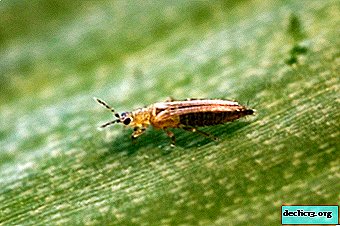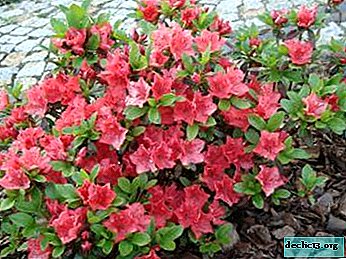Omnivore thrips. What is this insect and how to deal with it?
 It is believed that thrips belong to one of the oldest species of insects and are the ancestors of all bugs. These pests are almost omnivorous, so they can settle on any plants.
It is believed that thrips belong to one of the oldest species of insects and are the ancestors of all bugs. These pests are almost omnivorous, so they can settle on any plants.
It is very difficult to deal with them, and when the economy is large, it is almost impossible to exterminate the entire population.
This article will talk about what kind of insect it is, what are the causes and signs of its appearance on the plant.
Who or what is it?
Thrips (Thysanoptera) - an insect that belongs to the order of the vesicle and the family of fringed. The name of the detachment is due to the presence on the paws of its representatives of suction cups that look like bubbles. This device allows them to hold on to the leaves and jump well.
In terms of speed and distance, which thrips can overcome in a jump, they are only comparable with fleas. Fingers have been nicknamed the small black hairs, which cover the wings. However, to see them without a powerful microscope will not work.
Reference! Thrips lead a secretive lifestyle, with the exception of larvae that prefer group development.Larva
The development of thrips begins with an egg and goes through 5 stages.
| Stage | Period | Description |
| Egg | 12-13 days | It is located under the skin of the leaves of the affected plant. |
| Larva | 1-2 weeks | It is mobile, it feeds on the sap of plants. |
| Pronimfa | 1-3 days | The beginnings of the wings appear, ceases to feed. |
| Nymph | 2-3 weeks | There are wings, but are underdeveloped, fringe has not yet appeared, does not feed and does not fly. |
| Imago | until death | A sexually mature individual flies, jumps, eats. |
The life expectancy of thrips is from 25 to 45 days, the rate of their development depends on temperature - the warmer, the faster.
After the lichka leaves the egg, she continues to live on the leaves of the plant for another 8-10 days to provide herself with food. At this stage of development, the insect resembles an adult, only smaller and without wings. After the birth of the light, the color of her translucent body is almost white, then it acquires a yellowish, grayish or greenish tint.
The larva is active and able to move quickly. By the end of the two-week period, she descends from the plant and hides in the soil. At a depth of 10-15 cm, the insect completes its development, gaining wings. Under the ground, the larva is located for 4-5 days, where it molts several times and turns into pronymphus, and then into a nymph.
How it looks: description and photo
Depending on the species, the body of thrips can have a length of 0.5 to 14 mm. In the post-Soviet territory, small insects are widespread - up to 1-2 mm, individuals prefer to live in the tropics more. The body of an adult bug can be gray, brown, tan or black. It has an elongated fusiform shape and is divided into 11 segments.
The oral apparatus is piercing-sucking, which allows the insect to quickly make holes in plants and pump out the juice. There is also a pair of long antennae on the head. Most species are owners of slender short running legs, on each of which, in addition to the suction cup, there is a tooth. Also, the insect is equipped with 2 fringed wings with 2 or 3 veins.
Look at the photo of what thrips looks like on cucumbers:



Causes of the pest
Thrips are very resistant parasites that also multiply at lightning speed - in a week they are able to double their numbers. Most often, pests appear in places where dry and warm air. Therefore, those crops that are rarely sprayed and watered are in particular danger.
Thrips get into greenhouses through doors or windows that are open for airing, or they are brought in by people on their own - along with infected seeds or substrate. Pests can enter indoor plants in the same way, or move from newly purchased infected flowers and presented bouquets.
Larvae of the parasite are able to winter in the ground or compost heap. Therefore, it is necessary to dig up the soil in the fall, and it is better to place the compost pile away from the beds.Where does it appear?
Thrips attacks affect all cultures, but there are plants that suffer more often than others. Among the flowers growing in the garden, thrips are most indifferent to:
- gladiolus;
- lilies;
- iris
- roses;
- bells;
- chrysanthemum;
- astram;
- daisies.
Depending on the plant, thrips behave differently:
- on some flowers they lay larvae in leaves;
- others have buds.
The same thing happens with nutrition.
Of indoor plants, thrips prefer:

- begonia;
- an orchid;
- balsam;
- Anthurium
- violet;
- ficus;
- gloxinia;
- chlorophytum;
- azalea;
- gardenia;
- palm tree;
- fuchsia;
- dracaena;
- amaryllis etc.
What harm do they do?
- Larvae and sexually mature individuals feed on the sap of plants, resulting in damage on their surface. This leads to the death of tissues, the formation of holes, falling leaves, deformation of the buds and the curvature of the stems. So the plant quickly loses its attractiveness and the chances of further development.
- Thrips are also often carriers of fungal pathogens. And since as a result of the life of insects, plants have a weakened immune system, they quickly become infected and die. The spread of the disease is further accelerated by the contaminating, sticky fluid that thrips secrete.
- Thrips multiply rapidly, are able to jump and fly far, the probability that in a few weeks they will destroy most of the surrounding plants is very high. Therefore, it is necessary to detect the parasite as soon as possible and begin to exterminate it.
Signs of plant damage
It is quite difficult to find the first foci of pest damage - insects hide well and choose one plant from the group for the "base". However, if you do not neglect the inspections, you can notice their presence in time.
In the early stages of infection, the presence of parasites gives out yellowish or colorless spots, stripes and streak on leaf blades or petals. In the affected areas, small punctures are noticeable - points in places where insects drank juice. Over time, the spots begin to grow, then holes form in their place. After - wilting and falling of leaves and petals from flowers will begin.
 Examples of infection in different cultures:
Examples of infection in different cultures:
- onion - light yellow spots on feathers that completely dry over time, the bulb remains small and undeveloped;
- pumpkin and cucumber - angular spotting appears on the leaves, then they turn brown and the crop dies completely;
- bean - the fruits are deformed, the flowers do not develop, gray or brown spots appear on the pods;
- roses - the edges of the petals darken, and the leaves become covered with colorless spots, the bushes stop in development, the buds are formed irregularly.
Ways to fight
If thrips is detected, immediate action is required. to stop their reproduction and distribution. The main thing is to quickly isolate the affected plant from others. This should be done carefully so that the thrips do not fly to a new place. Then you need to inspect all the plants that were located nearby.
If a houseplant has been infected, the place where it stood should be disinfected. And the flower itself needs to immediately remove the damaged parts, and then arrange a shower. If this is not possible, then wipe it with a sponge dipped in soapy water, wrap it in polyethylene and leave it for a couple of days.
Next, go to the processing. In the early stages, you can do with folk remedies:
- Especially popular are water-based spray solutions with the addition of onions or garlic, or olive oil.
If it is not possible to spray the plant, you can chop the garlic and spread it near the stem. Then place the whole flower under a plastic bag and leave for 2-3 hours.
- In the fight against parasites, infusions of marigold, chamomile, celandine, tobacco, dandelion roots, potato leaves or tomatoes also showed themselves well.
 In advanced cases, it is better to immediately resort to the use of chemicals. The main thing is to use them carefully and according to the instructions. In the fight against thrips are effective:
In advanced cases, it is better to immediately resort to the use of chemicals. The main thing is to use them carefully and according to the instructions. In the fight against thrips are effective:
- Actellic
- Confidor
- Intavir
- Fitoverm;
- Agravertin;
- "Karbofos";
- "Pegasus";
- "Regent", etc.
Contact poisons do not act on eggs and nymphs of pests - they are protected by a shell.
Some plants painfully tolerate the interaction of moisture with leaves, so spraying is not suitable for them. In this situation, you can use predator insects:
- Bedbugs: Orius laevigatus, Orius.
- Ticks: Amblyseius cucumeris, Amblyseius barken, Amblyseius degenerans.
They can be bought at flower shops.
Reference! After destroying the thrips population, predator insects themselves will die.Preventative measures
Any disease is easier to prevent than to cure. To minimize the risk of parasites, the following recommendations should be followed:
- Do not contain plants in low humidity.
- Periodically arrange the colors of the souls.
- Do not allow the soil to dry out.
- Perform regular inspections.
- Place special sticky traps on the plant.
- Sterilize the substrate before planting and transplanting.
- Quarantine for new plants.
- Bouquets should be placed away from indoor flowers.
- Remove weeds regularly.
To protect the plants, you can periodically spray them with infusions of flowers with a strong aroma.
The small size, the ability to hide, the ability to multiply quickly and resistance to chemicals makes thrips very dangerous insects that can destroy ornamental plants or crops. Therefore, you should not lose vigilance and forget about preventive measures: after all, forewarned means armed.

















